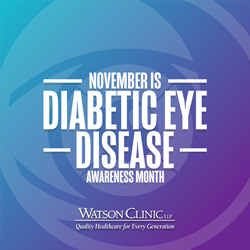 Anyone with diabetes—type 1, type 2 or gestational—is at risk for diabetic retinopathy. So if you have diabetes, it's good for you to learn as much as you can about this eye disease, including these 10 important facts.
Anyone with diabetes—type 1, type 2 or gestational—is at risk for diabetic retinopathy. So if you have diabetes, it's good for you to learn as much as you can about this eye disease, including these 10 important facts.
1. Diabetic retinopathy occurs when high blood sugar damages your retina—the light-sensitive lining found at the back of your eye. Sugar can block tiny blood vessels in your retina, causing them to bleed or leak fluid. Your eyes try to compensate by growing new blood vessels. These new blood vessels don't work as well.
2. Diabetic retinopathy may not cause any symptoms at first. But sometimes early stages of the disease can cause changes in vision, such as trouble reading or seeing things that are far away. These symptoms may come and go.
3. As the disease progresses, damaged blood vessels in the retina start to bleed into the center of the eye. Symptoms can include floating dark spots or streaks that look like cobwebs, blurred vision, a dark or empty spot in the middle of your vision, and trouble seeing at night.
4. Diabetic retinopathy can lead to vision loss and blindness.
5. Diabetic retinopathy can trigger other problems in the eyes. These include diabetic macular edema (DME), in which the blood vessels in the retina leak fluid and cause swelling in the macula, which is part of the retina. Diabetic retinopathy also can lead to a type of glaucoma.
6. Your risk for developing diabetic retinopathy increases the longer you have diabetes.
7. Your eye doctor can find diabetic retinopathy early during a dilated eye exam. This is why it's so important for people with diabetes to get regular eye checkups. Early treatment can halt damage to your eyes and prevent blindness.
8. You can lower your risk for getting diabetic retinopathy by controlling your blood sugar, blood pressure and cholesterol levels.
9. To slow the development of diabetic retinopathy:
• Take your diabetes medicine as prescribed.
• Follow a healthy diet.
• Be physically active.
• Avoid alcohol and smoking.
10. Diabetic retinopathy can be treated in several ways. One is through injections of medicine in your eyes. Another is laser treatment, which can shrink blood vessels and stop leaking. Surgery is also sometimes used to treat the disease.
Housed at Watson Clinic Main, our team of optometrists and ophthalmologists can detect and treat potential vision issues resulting from diabetes before they become severe. Call 863-680-7486 for more information and to schedule an appointment.
Source: National Eye Institute